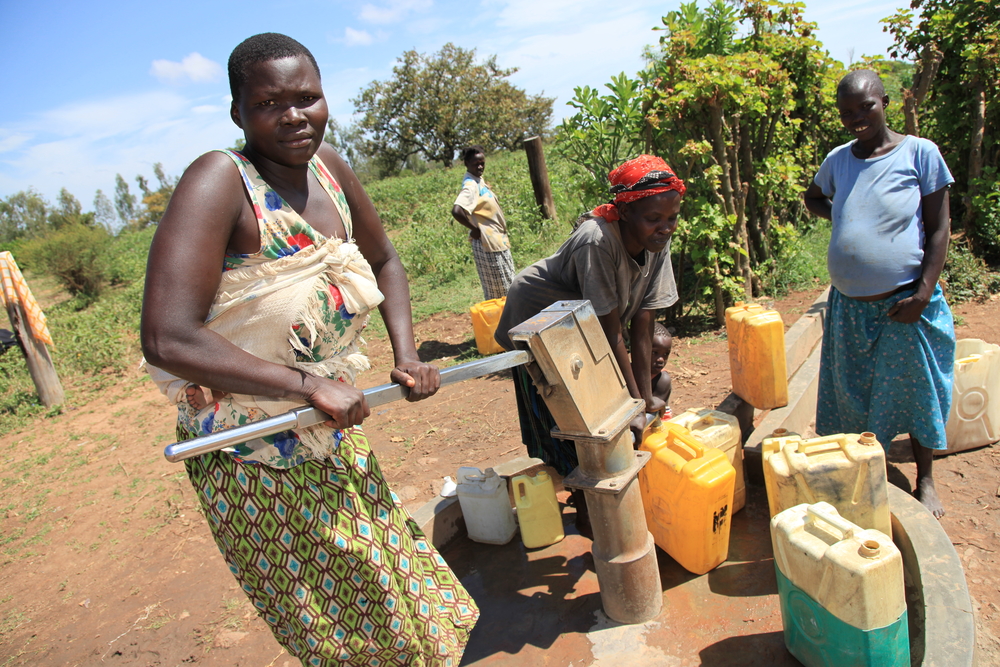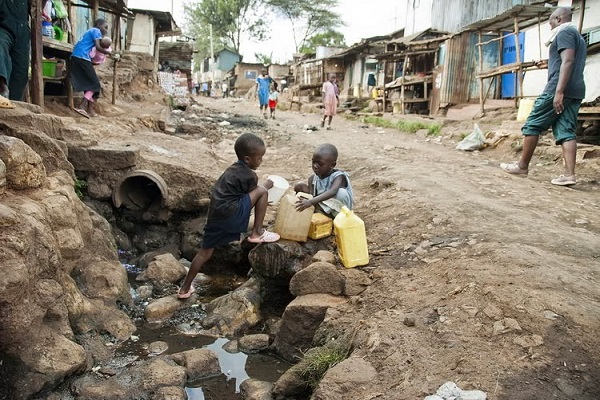The Uganda water crisis is a warning sign for the entire world that each of us has to step in and put a stop to human-induced climate change and water pollution before it is too late.
According to the 2018 Water Gap: State of the World’s Water Report issued by Water Aid, around 844 million people struggle to gain access to clean, safe water, warning that the number has increased with almost 200 million since the previous count. It seems that now we share a world where more than 60% of humankind lives in water-stressed areas that are closing into water scarcity.
The changes from previous reports are dramatic: statistics include now both the source people get their water from and the distance they need to travel to access clean water. As one can easily imagine, these criteria led to shifts in rankings, with new countries making it in the top places with the lowest access to water.
Water Richness vs. Water Poverty – The Paradox of Uganda, Nepal, and Pakistan
One of the most staggering issues with this report and water scarcity, in general, is that a handful of countries are real places of wonder when it comes to resources and… yes, water. Set in areas of natural abundance, some countries struggle with water poverty. How did they end up here? Why are some of the wealthiest countries in the world (water-wise) some of the poorest when it comes to drinkable, safe, clean water?
We will try to understand these matters next, by looking into the three case studies. Today we will begin with Uganda water crisis, a country that had and still has its fair share of trouble, while it struggles with solving its current water crisis.
The Uganda Water Crisis: The Tragic Paradox of One of the Largest Sources of the Nile

The Status Quo
Uganda hosts the largest river in Africa and one of the largest sources of the Nile. Wetlands, rivers, and lakes cover around 20% of the country’s total surface, as Uganda lies mostly in the Nile River’s drainage basin. Research shows that Uganda – with 66 cubic kilometers of renewable water resources every year – has enough fresh water to entertain economic growth and reduce poverty, together with a significant number of waterborne diseases.
Moreover, the country has the water infrastructure, but poor management, lack of durable and sustained operations or efficient maintenance rendered it useless. The current infrastructure does not meet the standards in accessibility, quantity, or quality.
While Uganda knew years of stability and progress, just like Nepal, it began suffering from climate change’s consequences – unreliable rains. Moreover, the overpopulation, the neighboring conflict with South Sudan, and Ugandan hunger problems stunt the country’s development.
The Uganda Water Crisis
Speaking of poverty, the UNDP report shows that 35.9% of the population lives below the income poverty line, with 53 under-five children dying per 1,000 live births. As we approach the water crisis in Uganda, we have to raise awareness on the fact that 31.6 people out of 100,000 die from unsafe water, poor sanitation, and improper hygienic services.
The Water Aid report places Uganda, as of 2018, on the third position among the top ten countries with the lowest access to water. What is even more tragic is that in Uganda, only 38% of the population have access to safe, clean water, close to their homes.
According to the Swiss RE Foundation
More than 30% of Ugandans lack access to secure water sources (via World Health Organization). The situation is not much better for the remainder of the population, with 60% of people reliant on boiling water to drink and 10% on purchased bottled water. As a result, water-borne illnesses remain the top cause of death among children under the age of five.
When it comes to appreciating the severity of the water crisis in Uganda, we have to refer to three main issues that need our attention.
Climate Change
Uganda is one of the most vulnerable countries to climate change and its populations’ life and wellbeing rely on the climate. Facing periods of flood and periods of drought, Uganda faces two types of climacteric disturbances:
- Natural
- Human-made
The human-made climate change has a severe impact on Uganda’s rainfall patterns, leading to dramatic draughts with socio-economic and even life-threatening impact.
However, recent reports offer dramatic provisions for the population and the country itself:
Human-induced climate change is likely to mean:
- increased food insecurity;
- shifts in the spread of diseases like malaria;
- soil erosion and land degradation;
- flood damage to infrastructure and settlements and shifts in the productivity of agricultural and natural resources.
It will be the poor and vulnerable who feel these impacts the hardest, though climate change has serious implications for the nation’s economy, with, for example, a shift in the viability of coffee growing areas potentially wiping out the US $265.8 million or 40% of export revenue.
Exacerbating poverty and triggering migration as well as heightened competition over strategic water resources, climate change could lead to regional insecurity.
Water Contamination
Diarrhea, dysentery, cholera, typhoid, Ebola, and Marburg are major public health problems in Uganda, despite its economic growth in the past years. Poor sanitation, unsafe water sources, poor hygiene, and runoff of solid waste contaminates waterways and further aggravates the populations’ vulnerability in the face of waterborne diseases and illnesses.
Nevertheless, one of the biggest problems Uganda faces is trachoma, a blinding disease endemic in 39 out of 112 Ugandan districts. This infectious eye disease caused by Chlamydia trachomatis concerns not only the World Health Organization but the Ugandan Ministry of Health too, as it estimates ten more million people to be at risk in the future.
The WHO stepped in with its SAFE Strategy for 2020. Among the essential guidelines of this strategy, environmental improvement takes a central role. The eradication of trachoma entails better access WASH, together with inclusive, community-based interventions.
Globally, the WHO states that trachoma takes a substantial economic toll in terms of lost productivity from blindness and visual impairment. The estimations revolve around US$ 2.9 – 5.3 billion each year, increasing up to US$ 8 billion when trichiasis is also present. However, the WHO admits that trachoma eradication requires joint efforts from authorities and actors playing a role in water safety, sanitation, and socioeconomic development.
Water Pollution
When it comes to this problem, in particular, Uganda deals with high levels of nitrates in the water, but this is just the beginning. Uganda deals with many issues keeping the proverbial vicious circle running, the first of them being agriculture.
Causes of Water Pollution in Uganda
Since about 80% of the population relies on agriculture and fishing, the environmental problems did not take long to appear: soil erosion, deforestation, wetlands drainage, biodiversity losses, reduced land capacity and increased air pollution, soil, and water pollution.
On the other hand, the growth of urban population and the uncontrolled and poorly managed industrialization burden the already frail infrastructure. Emerging economic sectors, such as mines, farms, urban settlements, and more have heavily polluted the wetlands. Moreover, pollution plagued Lake Victoria and the White Nile River – issues that negatively influence the entire world, not just the country.
Perspectives for the Future
Experts agree that NGOs, authorities and other actors need to join efforts in promoting awareness regarding the links between population, health, poverty, and environment. Currently, many organizations run projects and build models of good practices on WASH, the environment in general, advocacy and the development of healthy communities whose examples are replicable.
Organizations like World Vision and the We Are Water Foundation do everything they can to educate and empower communities to identify and build safe sources of water and make lifestyle changes that will lower the poverty level of the country in the long run.
What Can You Do to Help
In this day and age, you have a handful of alternatives to get involved and become a water-saving superhero even at a distance. Today, there are many organizations trying to tackle the global water crisis and reduce water poverty around the world. You can check them here and start donating or discussing with the people involved there to learn more about how you can volunteer or make other types of contributions.
Another way to get involved and make a significant change is to look for companies that assumed to take seriously the concept of “corporate social responsibility.” There are many companies and manufacturers producing water filters and water accessories that give back to communities dealing with a water crisis, water poverty, and social/economic issues due to overall pollution.
Support Others who Support the World
For instance, LifeStraw gives back while you shop. Their charity efforts involve more than just delivering portable life filters to Uganda but also developing sustainable educational programs lasting for five years. According to their website, LifeStraw
Is active in over 64 countries, making the product available to a wide group of partners seeking to provide access to safe water in communities in which they work. Whenever possible, LifeStraw seeks to provide on-the-ground training and education to partner organizations implementing programs with LifeStraw products. Our partnerships range from WHO and other UN organizations to local governments to small non-profits operating at a village level.
Specifically, you can buy a LifeStraw portable water filter for all your eco-friendly water needs or a LifeStraw gravity portable water filter for disaster preparedness or relief. The company invests some part of your money into humanitarian aid, educational programs, and solving several water crisis and water poverty aspects plaguing the locals’ quality of life.
Pure Aqua is another company involved in solving the water crisis in Uganda. As a manufacturer of reverse osmosis water filtration systems and other types of water treatment devices, Pure Aqua made it its goal to supply
Water purification systems that are designed to end the water and sanitation problem in Uganda. Our water treatment projects are implemented on the national and local levels with the goal of making sweeping changes in regards to the Ugandan’s standard of living. This change will be brought by improvements in:
- Executing the utilization of drying racks
- Building enhanced hand washing equipment and latrines
- Maintaining clean water
- Improved hygiene and sanitation
Pure Aqua manufactures water treatment systems that meet the World Health Organization requirements.
There are other reverse osmosis filters’ manufacturers involved in solving water crisis aspects around the world. APEC and iSpring come to mind, while Grayl – producer of some of the best filtered water bottles on the market today – is a proud member of the 1% for the Planet organization.
What Does the Future Hold for the Uganda Water Crisis?

To say that the situation in Uganda this year is dire would be an understatement. Facing a continuous and severe water crisis that does not seem to end any time soon, people in Uganda are relying less and less on international organizations, NGOs, companies, and people for relief and started taking the problem in their own hands.
After benefitting from educational programs regarding water sanitation, hygiene, and building toilets, a few communities began digging for wells to gain access to safe, clean water. Unfortunately, in the areas gravely affected by drought and pollution, such endeavor is not likely successful.
We will continue in the next weeks with our second case study referring to the water crisis and water poverty in water-rich countries. We will focus on Nepal, a place of natural wonder, one of the wealthiest countries in terms of freshwater resources and, yet, one of the poorest and the most water-stressed.